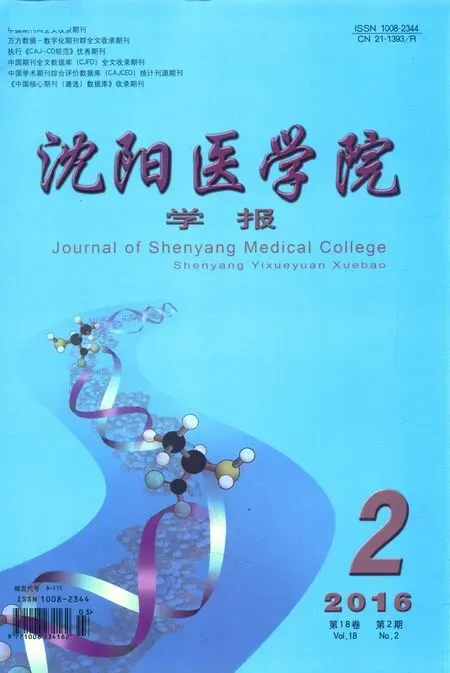抗肿瘤坏死因子疗法在炎症性肠病中的应用
沈浩,陆会飞,韩真
(皖南医学院弋矶山医院消化内科,安徽芜湖241001)
抗肿瘤坏死因子疗法在炎症性肠病中的应用
沈浩,陆会飞,韩真*
(皖南医学院弋矶山医院消化内科,安徽芜湖241001)
[摘要]目前,抗肿瘤坏死因子疗法在炎症性肠病的治疗中发挥着重要的作用。在炎症性肠病中使用抗肿瘤坏死因子抗体可能是至关重要的,以实现最终目的即肠道黏膜愈合。在疾病的早期阶段,特别是在克罗恩病患者中,建议使用抗肿瘤坏死因子抗体。但由于其成本、副作用、药物浓度监测等问题,使抗肿瘤坏死因子抗体备受争议。本文就最新相关数据来探讨抗肿瘤坏死因子抗体在炎症性肠病中的应用。
[关键词]抗肿瘤坏死因子疗法;黏膜愈合;溃疡性结肠炎;克罗恩病
炎症性肠病(inflammatory bowel disease,IBD)是一种慢性复发与缓解交替出现的一种原因未明的肠道疾病,包括溃疡性结肠炎(ulcerative colitis,UC)和克罗恩病(Crohn’s disease,CD)。近几十年来,IBD的发病率持续增高,特别是在经济发达的北美、欧洲以及亚洲的日本等。CD在北美和欧洲的发病率分别为20.2/10万人和12.7/10万人,而UC的发病率则为19.2/10万人和24.3/10万人。在我国,大约有60万IBD患者,UC和CD的发病率分别为11.6/10万人和1.4/10万人。IBD可发生在任何年龄,多见于20~40岁。男女性发病率无明显差别[1]。
过去,IBD以控制症状和体征作为最终目标,原因是传统的治疗方法大都无法促进黏膜愈合[2]。使得临床症状缓解与黏膜愈合之间缺乏相关性,也就难以判断黏膜愈合对IBD自然病程的影响。临床经验表明,抗肿瘤坏死因子抗体不仅可以缓解临床症状,而且可以促进肠道黏膜的愈合,因此黏膜愈合已作为IBD治疗的新目标[3-4]。有学者还建议把控制胃肠道损害和相关并发症的发生作为治疗的最终目标[5-6],但目前尚缺乏足够的证据。
目前,有4种抗肿瘤坏死因子单抗可应用于IBD患者中,分别是英夫利昔单抗、阿达木单抗、赛妥珠单抗、戈利木单抗。他们属于单克隆抗体,可以选择性地阻断肿瘤坏死因子-α(tumor necrosis factor-α,TNF-α)[7-8]。其作用机制是由于IBD患者的血清TNF-α水平明显增高,抗TNF-α抗体通过与TNF特异性结合,可使黏膜局部淋巴细胞聚集,使表达TNF-α的炎症细胞发生凋亡,从而使黏膜炎症消失。
1黏膜愈合与IBD
1.1IBD治疗的最新目标是实现胃肠道黏膜的愈合[9]。目前,对黏膜愈合缺乏一个准确而可靠的定义,特别是在UC治疗中。临床上,对黏膜愈合可以使用不同的量化评分,CD主要是CD内镜严重程度指数(Crohn’s disease endoscopic index of severity,CDEIS)和简化的CD内镜评分系统(simple endoscopic score for Crohn’s disease,SES-CD);而对于UC主要是梅奥内镜评分(Mayo endoscopic subscore)和UC内镜下严重度指数(ulcerative colitis endoscopic index of severity,UCEIS)。深度缓解是指黏膜愈合且不伴有任何临床症状[10],内镜检查并不是总能预测组织学缓解,把它作为一种目标目前有待探讨[9]。不过在UC中,有组织学缓解的患者要比无组织学缓解的患者可以显著降低疾病爆发的风险和大肠癌发生的风险。
黏膜愈合与IBD的低复发率、低住院率以及低手术率之间有着一定的联系。黏膜愈合可以预测UC患者发生大肠癌的风险。这些都突出了黏膜愈合在IBD治疗中的重要性。
1.2抗肿瘤坏死因子疗法与黏膜愈合抗肿瘤坏死因子抗体能够快速地诱导IBD患者黏膜发生愈合。英夫利昔单抗是最早应用于IBD的抗肿瘤坏死因子单抗之一,大量研究表明它可以显著改善CD患者的临床症状,促进黏膜的愈合、预防瘘管的发生,对于中重度IBD患者疗效显著,可以明显提高患者的生活质量[11]。英夫利昔单抗的用法:静脉注射,剂量为5 mg/kg。D’Haens等[12]的一项多中心随机双盲对照试验发现CD患者使用英夫利昔单抗或安慰剂4周后,英夫利昔单抗组CDEIS评分低于安慰剂组(P<0.05),说明英夫利昔单抗可以促进CD患者黏膜的愈合。Colombel等[13]在英夫利昔单抗与硫唑嘌呤的试验中发现(第26周),单用硫唑嘌呤可以使16.5%CD患者发生黏膜愈合,单用英夫利昔单抗可以使30.1%患者发生黏膜愈合,两者联合应用则是43.9%。一般认为英夫利昔单抗可以使30.4%~73.1%的患者出现黏膜愈合[13]。
阿达木单抗也能达到黏膜愈合的作用,用法:皮下注射,剂量为0周160 mg,第2周80 mg,以后每2周40 mg维持。试验组CD患者在第1周和第2周分别给予160 mg和80 mg的阿达木单抗,而对照组为40 mg的维持剂量或者是安慰剂。在52周以后,试验组的黏膜愈合率大于对照组(P<0.05)[14]。Hébuterne等[15]在UC患者中也发现了同样的结果。
戈利木单抗在诱导和维持中重度UC中也发挥着重要作用。用法:皮下注射,剂量为0周、第2周及第4周400 mg,以后每4周400 mg维持。Sandborn等[16]研究发现,试验组患者口服100 mg戈利木单抗,对照组给予安慰剂处理,在第30周和54周观察黏膜愈合程度,试验组黏膜愈合率分别为27.8%和42.4%,而对照组分别为15.6%和26.6%。戈利木单抗同其他抗肿瘤坏死因子抗体一样,其安全性是一致的。
虽然黏膜愈合是IBD治疗的最新目标,但目前的实验数据都只是在24个月,没有长期的数据供我们参考[17]。在黏膜愈合之外,我们还要认识到IBD导致患者出现肠道损害及其并发症。尽管有诸多不足,但抗肿瘤坏死因子疗法在阻止胃肠道进一步损伤发挥了重要的作用。
2抗肿瘤坏死因子疗法与血清药物水平
虽然抗肿瘤坏死因子疗法在IBD治疗中随处可见,但它并非在所有患者中都能有效地控制病情。据相关报道,25%~40%的CD患者最初使用抗肿瘤坏死因子治疗时因不能忍受其不良反应而失去对治疗的应答[18]。在CD患者中,考虑到需要加强剂量,对英夫利昔单抗和阿达木单抗而言,患者年应答损失率分别在13%[19]和24%[20]。在UC患者中目前缺乏相关数据,尚不清楚。
目前,几个因素可能影响血清药物水平和药物功效。例如性别、体重指数、血清C-反应蛋白水平、血清TNF-α水平、与免疫抑制剂联合治疗等,它们可以增加抗肿瘤坏死因子抗体在血液中清除率[18],这在CD患者中尤为重要。抗肿瘤坏死因子抗体药物的清除率主要取决于经网状内皮系统受体介导的内吞作用。此外,网状内皮细胞还表达Brambell受体,它可以负责各种抗体(包括抗肿瘤坏死因子抗体药物)的抢救与再循环[21]。在重度炎症的情况下,这一机制可以刺激机体产生内源性的IgG,从而降低抗肿瘤坏死因子抗体的治疗半衰期[22]。严重肠道炎症也可能导致蛋白质丢失过多,增加粪便中抗肿瘤坏死因子抗体的排泄,也降低了血清药物水平。
抗肿瘤坏死因子抗体属于基因工程抗体,它们作为人体异种蛋白质,进入体内必然能产生特异性抗体。虽然阿达木单抗是完全性人源性抗INF抗体,但相比英夫利昔单抗(嵌合型抗体)和赛妥珠单抗(人源性抗体)似乎并没有产生较低的免疫应答反应。Nanda等[23]在一项关于血清抗英夫利昔单抗抗体在IBD患者中对血清药物水平及临床预后影响的荟萃分析中得知,在1 378例应用英夫利昔单抗患者血清中,抗英夫利昔单抗抗体(+)患者与抗英夫利昔单抗抗体(-)患者相比,其合并风险比(RR)是3.2(95%CI:2.0~4.9,P<0.01)。
在CD患者中,英夫利昔单抗水平超过3 μg/ml时,可以达到临床缓解且患者血清C-反应蛋白水平较低。阿达木单抗水平高于5 μg/ml时,血清C-反应蛋白水平较低并且提高了黏膜愈合率[24]。抗肿瘤坏死因子抗体的主要副作用是:感染,局部的注射反应(如红肿等),自身免疫反应[25]。抗肿瘤坏死因子抗体血清水平越高其不良事件发生率也越高,比如骨关节痛或者皮肤改变[26]。应用抗肿瘤坏死因子抗体时一定要注意患者有无以下禁忌证:机会性感染(特别是结核)、过敏反应、输液反应、重度心衰等[25]。
3抗肿瘤坏死因子抗体早期应用策略
3.1上阶梯治疗传统的治疗方法是首先基于氨基水杨酸类和类固醇类制剂,其次是免疫抑制剂(硫唑嘌呤、环孢素),最后是生物制剂(抗肿瘤坏死因子单抗)。不过这种上阶梯治疗策略在过去的十年间并没有改变IBD疾病的自然史[27]。在国内由于生物制剂价格昂贵,而不被作为一线治疗药物。如果客观存在疾病活动的迹象(如肛周病变、溃疡活动出血),建议早期(6个月)应用抗肿瘤坏死因子抗体进行干预。这策略可以避免过度治疗IBD。
3.2下阶梯治疗虽然上阶梯治疗策略受到广大医务工作者的认可,但最近有学者提出了新的观点,即高危患者可以首先考虑使用生物制剂以彻底控制症状,这种策略被称为下阶梯治疗。自上而下的方法包括抗肿瘤坏死因子抗体→免疫抑制剂→类固醇→氨基水杨酸类,以实现快速和有效的疾病控制。
考虑早期治疗与抗肿瘤坏死因子治疗,联合治疗的可能性(抗肿瘤坏死因子治疗的基础上加用免疫抑制剂)治疗方案也应被讨论。研究发现,在一些IBD患儿中联合治疗似乎是最有效的方案之一[28]。然而,在使用硫唑嘌呤失败的患者中,其疗效和其长期安全状况仍有争议[29]。因此,更多的数据还需要确定到底哪些患者受益于联合治疗。需要对患者进行严格的评估,包括患者的年龄、疾病的缓解、有无并发症的发生、药物使用禁忌证以及患者经济可承受能力等。
4展望
目前,在IBD患者中使用抗肿瘤坏死因子治疗被认为是一种重要的治疗方法。虽然其有效性和安全性在IBD的治疗中被大家公认,但是抗肿瘤坏死因子抗体的相关知识和适应证仍然在不断的发展,使用抗肿瘤坏死因子抗体的最终目标是实现黏膜愈合和预防胃肠道损害及患者的伤残。
同时,考虑到抗肿瘤坏死因子抗体并不是对每一例IBD患者都是有效的。新的不同作用机制的药物正在不断出现,比如:抗IL-6抗体、抗IL-13抗体及抗JAK抗体等,他们可以作用于不同靶点起到控制疾病的作用。
因此,通过我们对抗肿瘤坏死因子抗体在IBD中的认识和发展一些新的有效药物,我们最终的目标是改变IBD疾病的自然史。
参考文献:
[1]Molodecky NA,Soon IS,Rabi DM,et al.Increasing incidence and prevalence of the inflammatory bowel disease with time,based on systematic review[J].Gastroenterology,2012,142(1):46-54.
[2]胡品津.克罗恩病治疗新目标:黏膜愈合[J].胃肠病学,2011,16(2):65-67.
[3]Pineton de Chambrun G,Peyrin-Biroulet L,Lémann M,et al.Clinical implications of mucosal healing for the management of IBD[J].Nat Rev Gastroenterol Hepatol,2010,7(1):15-29.
[4]Panaccione R,Colombel JF,Louis E,et al.Evolving definitions of remission in Crohn’s disease[J].Inflamm Bowel Dis,2013,19(8):1645-1653.
[5]Pariente B,Cosnes J,Danese S,et al.Development of the Crohn’s disease digestive damage score,the Lémann score[J].Inflamm Bowel Dis,2011,7(6):1415-1422.
[6]Peyrin-Biroulet L,Cieza A,Sandborn WJ,et al.Development of the first disability index for inflammatory bowel disease based on the international classification of functioning,disability and health[J].Gut,2012,61(2):241-247.
[7]中华医学会消化病学分会炎症性肠病协作组.对我国炎症性肠病诊断治疗规范的共识意见[J].中华消化杂志,2007,27(8):545-550.
[8]Bernstein CN,Fried M,Krabshuis JH,et al.World Gastroenterology Organization Practice Guidelines for the diagnosis and management of IBD in 2010[J].Inflamm Bowel Dis,2010,16(1):112-124.
[9]Peyrin-Biroulet L,Ferrante M,Magro F,et al.Results from the 2nd Scientific Workshop of the ECCO.I:Impact of mucosal healing on the course of inflammatory bowel disease[J].J Crohns Colitis,2011,5(5):477-483.
[10]Molander P,Sipponen T,Kemppainen H,et al.Achievement of deep remission during scheduled maintenance therapy with TNFα-blocking agents in IBD[J].J Crohns Colitis,2013,7(9):730-735.
[11]Ben-Horin S,Kopylov U,Chowers Y.Optimizing anti-TNF treatments in inflammatory bowel disease[J].Autoimmun Rev,2014,13(1):24-30.
[12]D’Haens G,Van Deventer S,Van Hogezand R,et al.Endoscopic and histological healing with infliximab anti-tumor necrosis factor antibodies in Crohn’s disease:A European multicenter trial[J].Gastroenterology,1999,116(5):1029-1034.
[13]Colombel JF,Sandborn WJ,Reinisch W,et al.Infliximab,azathioprine,or combination therapy for Crohn’s disease[J].N Engl J Med,2010,362(15):1383-1395.
[14]Rutgeerts P,Van Assche G,Sandborn WJ,et al.Adalimumab induces and maintains mucosal healing in patients with Crohn’s disease:data from the EXTEND trial[J].Gastroenterology,2012,142(5):1102-1111.
[15]Hébuterne X,Lémann M,Bouhnik Y,et al.Endoscopic improvement of mucosal lesions in patients with moderate to severe ileocolonic Crohn’s disease following treatment with certolizumab pegol[J].Gut,2013,62(2):201-208.
[16]Sandborn WJ,Feagan BG,Marano C,et al.Subcutaneous golimumab maintains clinical response in patients with moderate-to-severe ulcerative colitis[J].Gastroenterology,2014,146(1):96-109.
[17]Baert F,Moortgat L,Van Assche G,et al.Mucosal healing predicts sustained clinical remission in patients with early-stage Crohn’s disease[J].Gastroenterology,2010,138(2):463-468.
[18]Danese S,Fiorino G,Reinisch W.Review article:Causative factors and the clinical management of patients with Crohn’s disease who lose response to anti-TNF-alpha therapy[J].Aliment Pharmacol Ther,2011,34(1):1-10.
[19]Gisbert JP,Panés J.Loss of response and requirement of infliximab dose intensification in Crohn’s disease:a review[J].Am J Gastroenterol,2009,104(3):760-767.
[20]Billioud V,Sandborn WJ,Peyrin-Biroulet L.Loss of response and need for adalimumab dose intensification in Crohn’s disease:a systematic review[J].Am J Gastroenterol,2011,106(4):674-684.
[21]Mould DR,Green B.Pharmacokinetics and pharmacodynamics of monoclonalantibodies:concepts and lessons for drug development[J].Bio Drugs,2010,24(1):23-39.
[22]Ordás I,Mould DR,Feagan BG,et al.Anti-TNF monoclonal antibodies in inflammatory bowel disease:pharmacokinetics-based dosing paradigms[J].Clin Pharmacol,2012,91(4):635-646.
[23]Nanda KS,Cheifetz AS,Moss AC.Impact of antibodies to infliximab on clinical outcomes and serum infliximab levels in patients with inflammatory bowel disease (IBD):a meta-analysis[J].Am J Gastroenterol,2013,108(1):40-47.
[24]李瑾,潘华勤,夏冰.抗肿瘤坏死因子-α单抗及其他生物制剂在克罗恩病中的应用[J].中国实用内科杂志,2014,34(9):867-870.
[25]Clark M,Colombei JF,Feagan BC,et al.American gastroenterological association consensus development conference on the use of biologics in the treatment of inflammatory bowel disease[J].Gastroenterol,2007,133(1):312-339.
[26]王诗怡,范一宏,吕宾.炎症性肠病生物治疗的不良反应及防治策略[J].胃肠病学和肝病学杂志,2015,24(8):1006-1010.
[27]Peyrin-Biroulet L,Harmsen WS,Tremaine WJ,et al.Surgery in a population-based cohort of Crohn’s disease from Olmsted County,Minnesota (1970-2004)[J].Am J Gastroenterol,2012,107(11):1693-1701.
[28]Panaccione R,Ghosh S,Middleton S,et al.Combination therapy with infliximab and azathioprine is superior to monotherapy with either agent in ulcerative colitis[J].Gastroenterology,2014,146(2):392-400.
[29]Renna S,Cottone M,Orlando A.Optimization of the treatment with immunosuppressants and biologics in inflammatory bowel disease[J].World J Gastroenterol,2014,20(29):9675-9690.
(文敏编辑)
Application of Anti-tumor Necrosis Factor Therapy in Inflammatory Bowel Disease
SHEN Hao,LU Huifei,HAN Zhen*
(Department of Gastroenterology,Yijishan Hospital of Wannan Medical College,Wuhu 241001,China)
[Abstract]At present,the anti-tumor necrosis factor therapy plays an important role in the treatment of inflammatory bowel disease.Using of anti-tumor necrosis factor antibody in inflammatory bowel disease in order to achieve the ultimate objective of intestinal mucosal healing may be crucial.In the early stages of the disease,especially in Crohn’s disease,it is recommended to use anti-tumor necrosis factor antibody.However,due to its cost,side effects,drug concentration monitoring and other issues,using of anti-tumor necrosis factor antibody is controversial.In this paper,the application of anti-tumor necrosis factor antibody in inflammatory bowel disease is explored with the latest data.
[Key words]anti-tumor necrosis factor therapy;mucosal healing;ulcerative colitis;Crohn’s disease
[收稿日期]2015-11-26
doi:10.16753/j.cnki.1008-2344.2016.02.016
[中图分类号]R574
[文献标识码]A
[文章编号]1008-2344(2016)02-0102-04
[通讯作者]韩真(1957—),男(汉),主任医师,副教授,研究方向:消化道疾病及内镜方向.E-mail:hanzhen1028@hotmail.com

